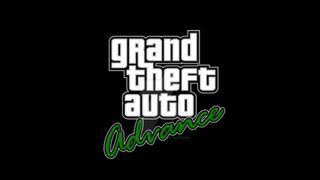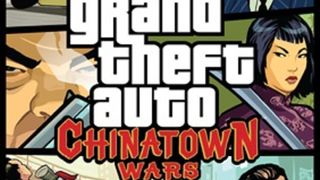The 26-year evolution of the GTA logo – from the original Grand Theft Auto to GTA 6
Grand Theft Advent | A visual tour of how the GTA logo has changed over the last quarter of a century

For a moment there, we didn't know for certain that GTA 6 existed. We knew that Rockstar was definitely on the cusp of premiering the next entry of its esteemed Grand Theft Auto series, but whether or not it'd be explicitly named number six was unconfirmed. That is, until the end of the much-anticipated, and since much-dissected, GTA 6 trailer – whose impressive glimpses of Vice City and protagonist Lucia in action concluded with a title card that boasted the series' now signature lowercase 'grand theft auto' logo sitting in front of an imposing 'VI' (or 6 in Roman numerals), colored orange and pink with palm tree silhouettes drawn inside its lines.
The trailer then confirmed that GTA 6 won't be with us until 2025, giving us plenty of time to cast our minds back over the series to date, not least the evolution of its logo. From the very first DMA Design-developed Grand Theft Auto in 1997, right through to our return to Vice in the year after next, read on for the many faces of Rockstar's enduring open-world crime sim.
Grand Theft Auto


Welcome to Grand Theft Advent – a month-long celebration of Rockstar's enduring crime sim series. Be sure to check in on our GTA 6 coverage hub for more every day throughout December.
Release date: November 28, 1997
Platform(s): PC, PS1, Game Boy Color
The one that started it all. Despite being set in the current day at the time, a lot of the original DMA Design-developed Grand Theft Auto's promotional material echoed a 1970s vibe – something that extended to its logo, with its cartoonish flames and font. The stars on either side of the letters here are interesting because while the series eventually adopted its now signature 'stars' wanted level system, the original GTA used talking policeman icons to signify how aggressive law enforcement were in pursuit. Moreover, while this logo is definitely cool, it wasn't used in-game – certainly not at the time – with this logo instead featuring on the start menu:

Not nearly as eye-catching, I'm sure you'll agree – but that was soon to change.
Grand Theft Auto: London 1969 and Grand Theft Auto: London 1961

Release date(s): April 30, 1999; June 1, 1999
Platform(s): PS1, PC
Grand Theft Auto's first expansion took us back in time and to the UK capital with flare and finesse. That's reflected in both the GTA: London 1969 expansion logo, and its follow-up, GTA: London 1961, with its Austin Powers-style badge and union flag colors.
Sign up to the 12DOVE Newsletter
Weekly digests, tales from the communities you love, and more
GTA 2

Release date: October 22, 1999
Platform(s): PC, PS1, Game Boy Color, Dreamcast
The term 'Grand Theft Auto 2' exists today on wiki pages and digital storefronts, but at the time the second mainline GTA game was known simply as GTA 2. While a natural evolution of the first game in mechanical, visual and top-down perspective terms, its logo struck out on its own with a yellow taxi cab in the sights of a distant sniper (despite the game not actually including sniper rifles as weapons).
Grand Theft Auto 3

Release date: October 23, 2001
Platform: PS2, PC, Xbox, iOS, Android
1997's Grand Theft Auto may have started it all, but it was GTA 3 that changed it. This was the first game to adopt the now iconic lowercase font that we associate with the series – and with some promo material at the time running with simply 'gta 3', this logo both looked back and forward.
Another interesting feature of the GTA 3 logo is tied to its box art. In the PAL region, a collection of the game's characters featured against a white background, whereas the US region was the first to use the grid style character splash that's consistent with the series' later entries.
Grand Theft Auto: Vice City

Release date: October 29, 2002
Platform(s): PC, PS2, Xbox, iOS, Android
Having landed on what would become a discernible and consistent font and logo with GTA 3, Vice City said so much with very little – its neon pink cursive a distinct nod to Tommy Vercetti's faux-Miami exploits in the mid-1980s.
Grand Theft Auto: San Andreas

Release date: October 26, 2004
Platform(s): PC, PS2, Xbox, PS3, Xbox 360, iOS, Android
Similar to Vice City before it, GTA: San Andreas used Old English lettering to subtly nod to the street-level themes of the latest Grand Theft Auto installment; this one set in the early 1990s and weaved around street gang culture.
Grand Theft Auto Advance

Release date: October 26, 2004
Platform: Game Boy Advance
A pretty straightforward one, this – a Grand Theft Auto game made specifically for Nintendo's Game Boy Advance handheld, named, that's right, Grand Theft Auto: Advance. This logo was used while marketing the game in 2004, however the game's box art simply ran with 'Grand Theft Auto', given each Game Boy Advance game ran with the handheld's branding flipped and left-aligned on the case.
Grand Theft Auto: Liberty City Stories & Vice City Stories

Release date: October 24, 2005; October 31, 2006
Platform(s): PSP, PS2
The respective prequel off-shoots of GTA 3 and GTA: Vice City, these logos portrayed the grit of the 3D Universe's Liberty City and the same beachfront 80s vibes of Vice. Where these games' logos came into their own, however, was in their box arts – each cover posting characters from their base games' timelines that fueled speculation before release.
Grand Theft Auto 4

Release date: April 28, 2008
Platform: PS3, Xbox 360, PC
A darker game in tone called for a darker logo in presentation. The standard logo was pretty cut and dry for GTA 4 to be fair, but the first steps of the series' HD universe in 2008 appear to prompt Rockstar to get creative with its promo logos – with the skyline one shared here my own favorite.
GTA 4: The Lost and Damned & The Ballad of Gay Tony

Release date(s): February 17, 2009; October 29, 2009
Platform(s): Xbox 360, PC, PS3
Like its base game, GTA 4's story mode DLC had cool standalone logos, again accentuated by their character-led box art. The jump in visual quality GTA 4 had over its predecessors was especially reflected by The Lost and Damned to this end.
Grand Theft Auto Chinatown Wars

Release date: March 17, 2009
Platform(s): PSP, Nintendo DS, iOS, Android
Like GTA 4's off-shoot DLC, this portable mainline off-shoot borrowed the same windowed branding style as its forerunners, with some bespoke lettering designed to reflect protagonist Huang Lee's heritage.
Grand Theft Auto 5

Release date: September 17, 2013
Platform(s): PS3, PS4, PS5, Xbox 360, Xbox One, Xbox Series X, PC
The logo we've spent a long time with, and surely the series' most famous. With the signature 'grand theft auto' logo sitting alongside a massive V (or 5 in Roman numerals) that was colored green with a 'five' wraparound akin to US paper currency.
GTA Online

Release date: October 1, 2013
Platform(s): PS3, PS4, PS5, Xbox 360, Xbox One, Xbox Series X, PC
Given the long-term success GTA Online has gone on to enjoy, its logo is perhaps the most understated of the lot. Who knows for sure, but an educated guess would suggest Rockstar couldn't have predicted the enduring statue of GTA Online back in 2013.
Grand Theft Auto 6

Release date: 2025
Platform(s): PS5, Xbox Series X
The latest of the lot, revealed at the very end of the GTA 6 trailer, and the culmination of everything that's come before it. Bold, bright and beautiful, with the same silhouetted stylings as GTA 4's Liberty City skyline – this time with a neon blue-to-pink-to-orange fade and waving palm trees.
These games like GTA can tide you over till the next one in 2025

Joe Donnelly is a sports editor from Glasgow and former features editor at 12DOVE. A mental health advocate, Joe has written about video games and mental health for The Guardian, New Statesman, VICE, PC Gamer and many more, and believes the interactive nature of video games makes them uniquely placed to educate and inform. His book Checkpoint considers the complex intersections of video games and mental health, and was shortlisted for Scotland's National Book of the Year for non-fiction in 2021. As familiar with the streets of Los Santos as he is the west of Scotland, Joe can often be found living his best and worst lives in GTA Online and its PC role-playing scene.

Assassin's Creed Shadows devs "actively looking at" an even harder difficulty mode for the RPG: "How challenging do you want it?"

Assassin's Creed Shadows' delays were mostly used to polish the RPG, creative director confirms, not for deeper changes brought about by Star Wars Outlaws reaction










